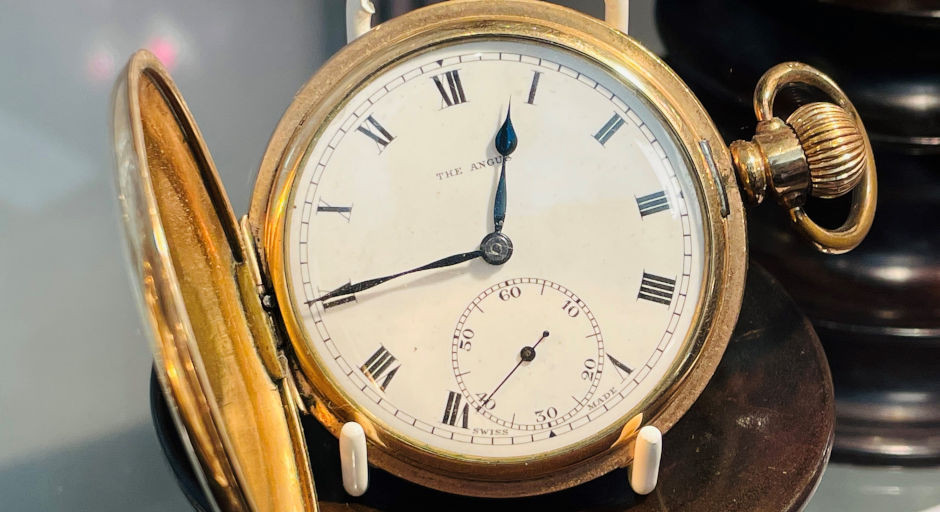
A history of the watch
Originally developed in the 16th century, ‘clock-watches’ were sized between a clock and a watch and were worn around the neck or fastened to clothing. By the 17th century, when Charles II introduced the waistcoat, men started to wear watches in their pockets, with women continuing to wear pendant watches. Largely handmade until the end of the 18th century, watches became much more common and cheaper models were manufactured for sale to sailors, with dials painted with maritime scenes in bright colours.
Common types of antique pocket watch
Antique pocket watches are identified by the watch face and the case and the following are the most popular forms of antique pocket watch.
Hunter case
This has a round hinged cover to protect the dial, with the stem and crown, or winding mechanism, usually situated at the number 3 position.
Demi-hunter case
Similar to the hunter case, a demi-hunter has a window in the cover so that the time may be viewed without opening it.
Open-face watch
This type of pocket watch has no protective cover for the dial and the stem and crown appear at the 12 position.
Pair-cased watch
Typical of the mid-18th century, a pair-cased watch is basically an open-face watch set into a hunter case. The watch is removed from the case to be wound before being replaced in the hunter case for protection.
Pocket watch makers of distinction
The name that appears on the dial of a pocket watch may not be the maker’s name but rather the retailer that sold it originally, likewise the branding on the watch movement. In the absence of the maker’s name, always look for an identifying mark or serial number which can usually be found on the bottom plate. Watches made by any of the following will be sought after and can command higher prices:
Waltham pocket watches
Established in 1850, Waltham led the way in the mass production of the pocket watch and are famous for the Waltham Traveller.
Tissot pocket watches
Tissot is a firm favourite with collectors of pocket watches and wrist watches and was established in Switzerland in 1853.
Longines pocket watches
Another Swiss watch maker of distinction, Longines were founded in 1832 and boast the oldest registered trademark, a winged, hourglass logo, which is engraved on the watch movement.
Rolex pocket watches
Instantly recognisable as a prestigious watchmaker, Rolex was established in 1905 by Hans Wildorf and Davis, becoming Rolex in 1908. Wildorf went on to register the Tudor brand of watches in 1926.
The rise of the wrist watch
Women began wearing wrist watches in the late 19th century, as timekeepers and fashion accessories, but the pocket watch continued to be the popular choice for men’s time pieces up until the early 20th century.
By World War I, advances in communications technology meant that foot soldiers needed to access the time quickly in order to coordinate manoeuvres in the trenches and the pocket watch was not a practical means of doing this. Hence ‘trench watches’ were some of the first mass-produced men’s wrist watches, filtering down to civilian street when marketed as a way for men to become more soldier-like and more masculine.
The earliest men’s wrist watches, however, were pocket watches that had been converted as many people could not justify the cost of a new watch when their old one was perfectly serviceable and fully functioning. In these cases, lugs were welded to the watch case and a strap attached.
What to look for when buying an antique or vintage watch
Condition – this can be divisive among collectors of vintage or antique watches. Some believe that the watch should be completely original, as it was when first manufactured while others realise that for a watch to have been well cared for, it should have been serviced regularly, which may involve parts being replaced. A vintage wrist watch with its original box and certificate will always command higher prices. The face of a vintage watch is important too; a face or dial which shows signs of age (NOT wear) will also be more desirable, and the more honest the dial, the better. Restored dials or dials that have been touched up should be avoided by the serious collector. This also applies to vintage watch hands.
Maker – watches by the makers above will always represent a good investment for the serious collector but the novice collector should go with their heart, and not underestimate the collectability of other brands such as Heuer and Breguet.
Where to buy an antique or vintage watch
To be confident that the watch you are considering is genuine, you must be able to trust the seller. Specialist dealers like our dealers at Hemswell will be able to tell you how they have checked the authenticity of the piece and many are accredited to carry out these authentications. When on site, our dealers are always happy to share their expertise and knowledge to buyers.
A selection of our antique and vintage watches can be viewed online, with many more available to browse at our beautiful site not far from historic Lincoln. More information can be found in our blog, ‘A guide to: Antique watches’.